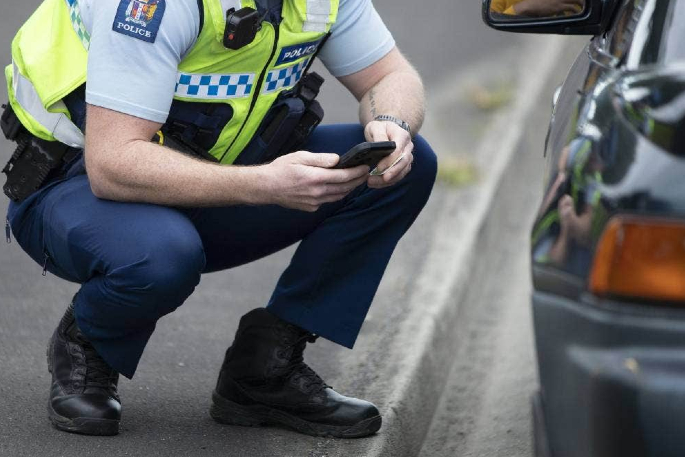It's a bizarre crime that can happen on a rural New Zealand road – or as part of what remains the world's biggest art heist.
It's impersonating a police officer, it comes with a maximum penalty of 12 months imprisonment, or a $15,000 fine, and since 2011, 85 New Zealanders have been convicted for it.
While a far cry from the 1990 Boston art gallery robbery involving fake cops that netted $500 million in Old Masters' works, there's one thing in common with all cases – a convincing front.
A farm assistant and a man with a baton and handcuffs at home are among 85 people convicted of impersonating a police officer over the past 11 years. Video: Stuff.
Stuff dug into the phenomenon of people impersonating police in the wake of a bizarre crime that took place on two separate April days in 2018, but was only resolved at Te Kūiti District Court this year with a sentence of community work.
It centred on a farm assistant called Glenn Alan Mathias who pulled over drivers, telling them he was a police officer, before he dispensed road safety advice.
 Police impersonator Shannen Cox was found to have an expandable baton, handcuffs with fitting key, and a "tactical belt" after he was arrested for his second time pretending to be law enforcement. Photo: Supplied/Stuff.
Police impersonator Shannen Cox was found to have an expandable baton, handcuffs with fitting key, and a "tactical belt" after he was arrested for his second time pretending to be law enforcement. Photo: Supplied/Stuff.
According to the police summary of facts, Mathias was driving his utility vehicle in Puketapu when he 'activated flashing blue and red lights on the dash of his vehicle”.
The first victim, assuming he was a police officer, pulled over and stopped.
'The defendant walked up to the driver's door and told her she was lucky he was not on duty, claiming she had committed an offence by having her lights on full,” the summary says.
'After a brief conversation he turned his vehicle around and drove off.”
The second offence followed the same pattern, only with him telling the victim they had crossed the centre line.
 Traffic stops are a common entry point to the crime of police impersonation. Photo: Christel Yardley/Stuff.
Traffic stops are a common entry point to the crime of police impersonation. Photo: Christel Yardley/Stuff.
'He was asked for his police ID, but claimed he did not have it, but says he was from the Taupō Police,” the summary says.
'After giving some traffic safety advice he got back in his vehicle and drove off.”
An Official Information Act request to police means Stuff can reveal that since 2011, 85 New Zealanders have been convicted of impersonating a police officer, while 137 people in total were charged with the offence.
Another New Zealander to be caught playing cops – twice – was Shannen Cox.
In January 2019 he followed a driver on his motorbike into a parking building, approached the driver, declared himself an "authorised officer" and presented a "Land Transport badge".
At his sentencing it was revealed he had a prior conviction for impersonating police in 2013.
A search of his then residence also found an expandable baton, handcuffs with fitting key, and a "tactical belt".
Unusually, some explanation for his offending was also offered at the time as the court heard he had been the victim of a serious road crash in 2013.
He suffered a head injury which impacted some of his behaviour and "ability to function in a normal way in some regards", his sentencing judge says.
"I'm told that you are particularly sensitive, possibly oversensitive when it comes to road safety concerns."
 Triple RSA killer William Dwane Bell, pictured in 2002 at the murder trial, used a stolen police shirt to trick his way into the building. Photo: Phil Doyle/Stuff.
Triple RSA killer William Dwane Bell, pictured in 2002 at the murder trial, used a stolen police shirt to trick his way into the building. Photo: Phil Doyle/Stuff.
While there are plenty of examples of the impersonation being relatively harmless, one of New Zealand's most notorious crimes, the murder of three people at an RSA by William Bell, was conducted after he tricked his way into the building while wearing a stolen police shirt.
While how many people have committed this offence was easy to ascertain, why proved harder to answer.
Professor Richard Wortley of the University of Waikato and NZ Institute of Security & Crime Science, says he knew of no-one who could provide an expert view on the psychology behind the offending.
However, while he says it was not strictly his area of expertise, he says he believed such offending was likely motivated by a desire to exploit the power of police, to commit other crimes or 'fantasy fulfilment”.
His view, and echoes of the Mathias incident, find support in a 2012 research paper Police Impersonation: Pretences and Predators, published in the American Journal of Criminal Justice, by Associate Professor Callie Marie Renniuson and Professor Mary Dodge from the University of Colorado.
Their research, which they admit is a rarity on the topic, used United States case files on police impersonation from 2002-2010 and found the most typical impersonation 'involves an offender driving an unmarked car who uses a spotlight or red and blue flashing lights for a pull-over”.
'These [impersonation] incidents most often involve one victim, one offender, no witnesses, no weapon and result in no injury to the victim.”
 Assistant Commissioner Richard Chambers says police take the issue of impersonation seriously, and that the crime can sometimes be part of much more serious offending. Photo: Mark Taylor/Stuff.
Assistant Commissioner Richard Chambers says police take the issue of impersonation seriously, and that the crime can sometimes be part of much more serious offending. Photo: Mark Taylor/Stuff.
Their research also revealed how old the crime of police impersonation is, noting a historical account of 29 people caught impersonating law officers in London dated back to 1685.
One other person who has studied police impersonation is US-based lawyer James A. Walckner, who researched the topic for his Masters thesis.
He says it was cases just like Mathias' that prompted his interest.
'What I find intriguing are the police impersonators, such as Glenn Mathias, who engage in this risky behaviour for no obvious reason”.
He says he believes police impersonators can be broken into three categories.
'Wannabe, Materialistic, and Deviant,” he says.
 Research from the United States indicated some are drawn to impersonating police officers due to the ‘lure of authority, and ego enhancement.' Photo: Chris McKeen/Stuff.
Research from the United States indicated some are drawn to impersonating police officers due to the ‘lure of authority, and ego enhancement.' Photo: Chris McKeen/Stuff.
'The behaviour described of Glenn Alan Mathias in the Taupō case, where the act of impersonating a police officer itself is the ultimate objective, falls within the Wannabe category.
'His impersonation of law enforcement was not done in furtherance of material gain or sexually deviant behaviour. Consistent among police impersonators in the Wannabe category, Mathias acted alone and had a vehicle equipped with emergency lights,” he says.
Walckner says that while motivation in cases where the impersonation did not appear to be part of any wider criminal enterprise were unclear, 'an offender's desire for power over others or sense of grandiose should be considerations”.
That view appears to be supported by Renniuson and Dodge's research.
'In some instances, it is clear that the enticement of policing, the lure of authority, and ego enhancement played a role in the incident.”
Police impersonation is certainly taken seriously by New Zealand police, according to Assistant Commissioner Richard Chambers.
He says that while the offence was not common, 'it is a matter which Police takes very seriously.”
'We are aware of people impersonating an officer for matters which can be very minor in nature but also for far more serious offending,” he says.
'The public rightly expects to be able to trust that the person they are interacting with is a trained and serving Police officer who will deal with any matter appropriately, and those impersonating our staff risks undermining this trust.”



0 comments
Leave a Comment
You must be logged in to make a comment.